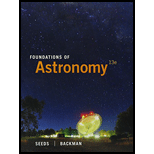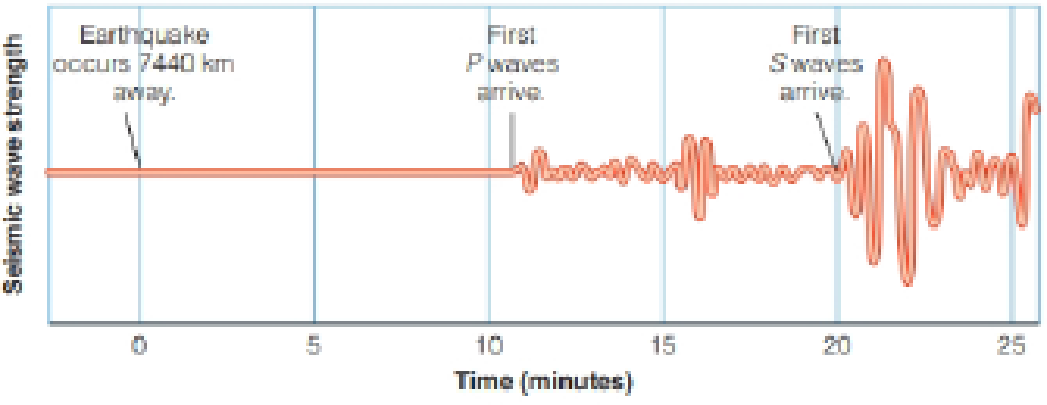
Concept explainers
Look at Figure 19-3. The earthquake occurred 7440 km from the seismograph. How fast did the P waves travel in km/s? How fast did the S waves travel? How long did the P waves and the S waves take to travel 100 km from the epicenter? Assume the wave speeds are constant.

The speed of
Answer to Problem 2P
The speed of
Explanation of Solution
Write the expression for speed of wave.
Here,
From the figure
Conclusion:
Substitute,
Substitute
The distance travelled from the epicenter is
Substitute
Substitute
The speed of
Want to see more full solutions like this?
Chapter 20 Solutions
Foundations Of Astronomy, Loose-leaf Version
- Look at Figure 19-3. The lag time is the difference between when the P waves arrived and when the S waves arrived. Using the earthquake data shown in the figure, what is the lag time? Form a general conclusion about the relationship between lag times and locations of earthquakes. Figure 19-3 A seismograph in northern Canada made this record of seismic waves from an earth-quake in Mexico. The first vibrations, P waves, arrived 11 minutes after the quake, but the slower S waves took 20 minutes to make the journey.arrow_forwardThe Hawaiian-Emperor chain of undersea volcanoes is about 7500 km long, and the Pacific plate is moving 9.2 cm a year. How old is the oldest detectable volcano in the chain? What has happened to older volcanoes in the chain?arrow_forwardLook at the hemispheres of Earth shown on the two pages of The Active Earth. Name a folded mountain range. Describe the locations of one subduction zone and one midocean rise.arrow_forward
- How are the inferred properties of Earths original atmosphere related to the location and timescale of Earths formation from the solar nebula?arrow_forwardOver the entire Earth, there are 60,000 km of active rift zones, with average separation rates of 5 m/ century. How much area of new ocean crust is created each year over the entire planet? (This area is approximately equal to the amount of ocean crust that is subducted since the total area of the oceans remains about the same.)arrow_forwardWhat Is KMT And What Are Its Assumptions?arrow_forward
- An igneous rock contains a radioactive Isotope that has a half life of 10 million years. Careful analysis shows that only one quarter of the original concentration of the parent isotope is left. How old is the igneous rock ?arrow_forwardWhat characteristics must Earths core have to generate a magnetic field?arrow_forward
 Foundations of Astronomy (MindTap Course List)PhysicsISBN:9781337399920Author:Michael A. Seeds, Dana BackmanPublisher:Cengage Learning
Foundations of Astronomy (MindTap Course List)PhysicsISBN:9781337399920Author:Michael A. Seeds, Dana BackmanPublisher:Cengage Learning
 AstronomyPhysicsISBN:9781938168284Author:Andrew Fraknoi; David Morrison; Sidney C. WolffPublisher:OpenStax
AstronomyPhysicsISBN:9781938168284Author:Andrew Fraknoi; David Morrison; Sidney C. WolffPublisher:OpenStax Horizons: Exploring the Universe (MindTap Course ...PhysicsISBN:9781305960961Author:Michael A. Seeds, Dana BackmanPublisher:Cengage Learning
Horizons: Exploring the Universe (MindTap Course ...PhysicsISBN:9781305960961Author:Michael A. Seeds, Dana BackmanPublisher:Cengage Learning Stars and Galaxies (MindTap Course List)PhysicsISBN:9781337399944Author:Michael A. SeedsPublisher:Cengage Learning
Stars and Galaxies (MindTap Course List)PhysicsISBN:9781337399944Author:Michael A. SeedsPublisher:Cengage Learning An Introduction to Physical SciencePhysicsISBN:9781305079137Author:James Shipman, Jerry D. Wilson, Charles A. Higgins, Omar TorresPublisher:Cengage Learning
An Introduction to Physical SciencePhysicsISBN:9781305079137Author:James Shipman, Jerry D. Wilson, Charles A. Higgins, Omar TorresPublisher:Cengage Learning





